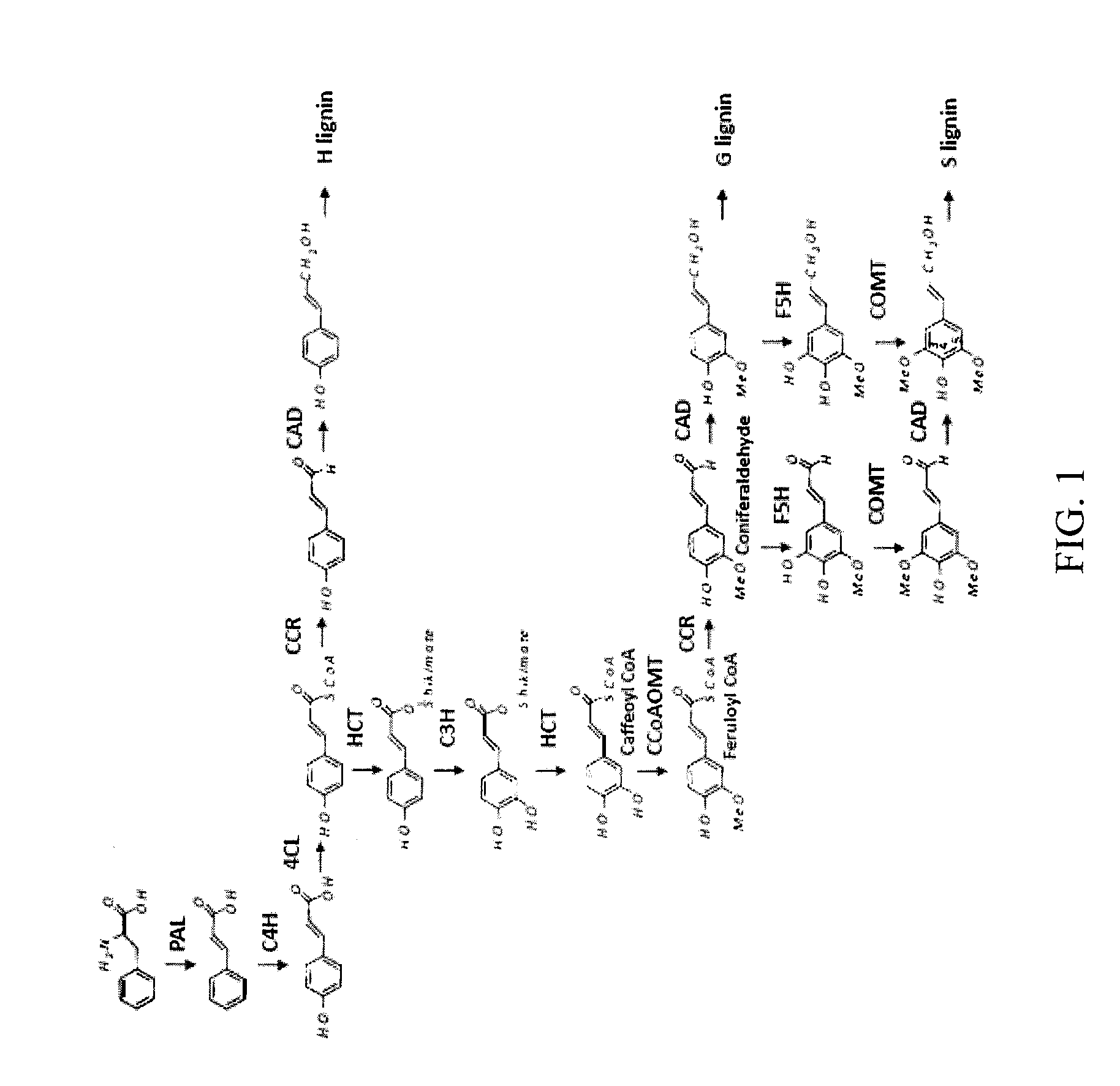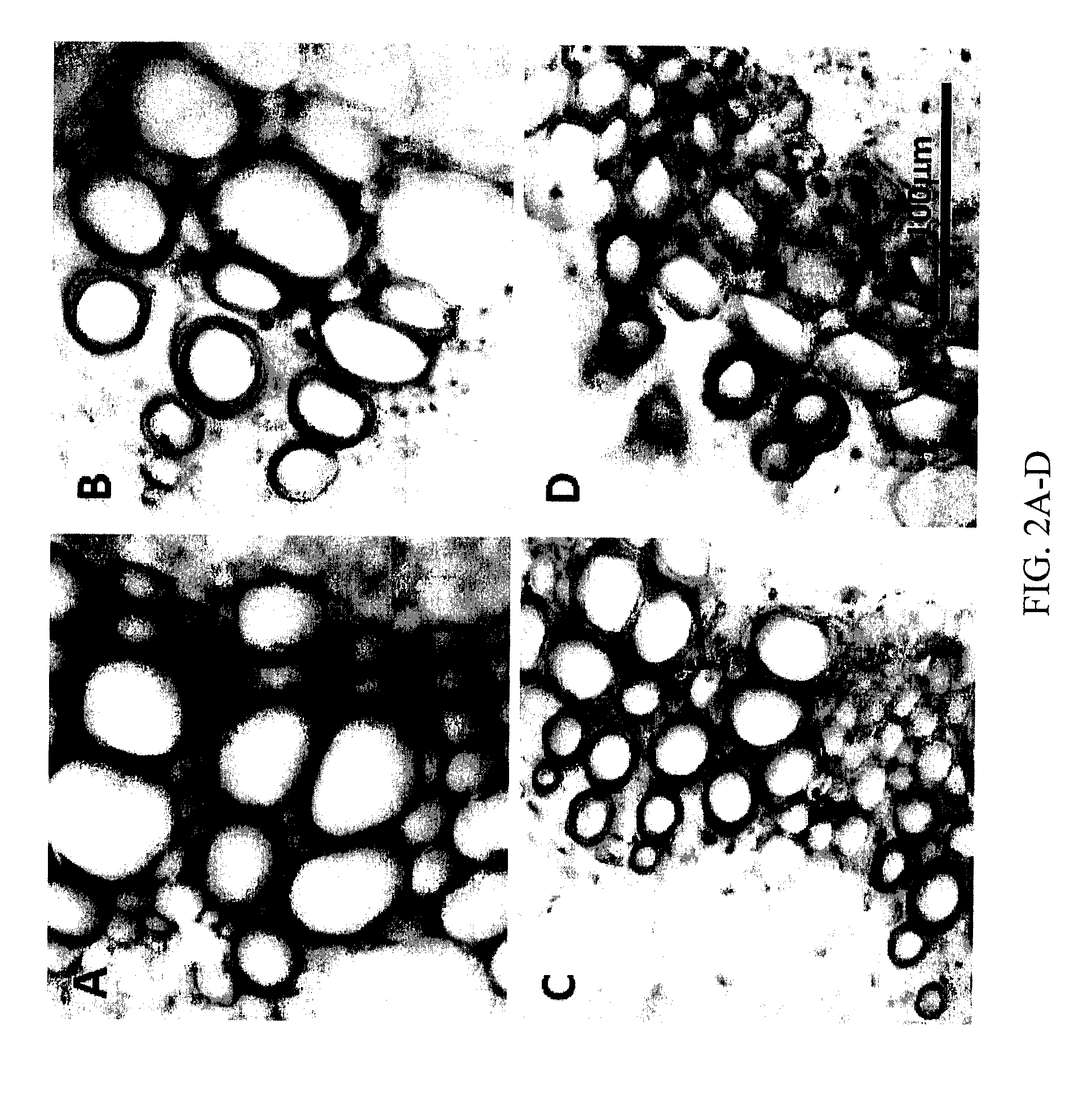Caffeoyl coa reductase
a reductase and caffeine technology, applied in the field of agriculture and plant genetics, can solve the problems of not being able to achieve the goal of genetic modification of plants to achieve these goals, increase carbon sequestration, and difficult digestion of animal feed, etc., to achieve the effect of reducing lignin content, enhancing digestibility, and increasing the digestibility of forage crops
- Summary
- Abstract
- Description
- Claims
- Application Information
AI Technical Summary
Benefits of technology
Problems solved by technology
Method used
Image
Examples
example 1
Phenotypes of Transgenic Alfalfa with Reduced Expression of Both COMT and CCoAOMT
[0180]Generation of transgenic alfalfa lines harboring RNAi constructs for the down-regulation of COMT or CCoAOMT has been previously reported (see, e.g., Chen et al., 2006). As observed in earlier studies using antisense constructs (Guo et al., 2001), RNAi-mediated down-regulation of CCoAOMT directed by the vascular-specific bean phenylalanine ammonia-lyse (PAL) 2 promoter results in reduced lignin yields with little if any effect on S lignin levels, whereas down-regulation of COMT drastically reduces S lignin (Chen et al., 2006). Down-regulation of either enzyme alone has little negative effect on plant growth.
[0181]If COMT and CCoAOMT are the only enzymes involved in monolignol O-methylation in alfalfa, and serve redundant functions, down-regulation of both enzymes together should lead to a major disruption of the lignin pathway. To study the effects of simultaneous down-regulation of both CCoAOMT an...
example 2
The Lignin Phenotype of Double OMT Knock-Downs Suggests a Role for COMT in the 3-O-Methylation of G Lignin Precursors
[0185]To determine lignin content and composition in the various progeny lines, stem samples were analyzed by the acetyl bromide method for total lignin content, and by thioacidolysis to determine monomer yield and composition (FIG. 3). Acetyl bromide lignin levels were reduced in all COMT and CCoAOMT single RNAi progeny when compared to the nulls, with the exception of CCoAOMT line 5, but were reduced further in some of the double knock-downs (FIG. 3A). The reduction in lignin in the double knock-downs was even more apparent when considered in terms of total thioacidolysis yield (FIG. 3B). However, six of the seven double knock-down lines, although exhibiting reduced S-lignin levels, produced more S-lignin than did any of the single COMT RNAi lines (FIG. 3B), and the S / G ratios of the double RNAi lines were, on average, only slightly lower than those of the nulls. T...
example 3
Substrate Preferences of Medicago CCRs Suggest the Involvement of Different Enzymes for Reduction of Caffeoyl and Feruloyl CoAs
[0187]Based on the conventional understanding of monolignol biosynthesis, 3-O-methylation by COMT would most likely occur at the level of caffeoyl aldehyde or caffeoyl alcohol, preferred substrates for the enzyme from alfalfa (Parvathi et al., 2001). This raises the question of the origin of caffeoyl aldehyde. Caffeoyl CoA has been described as a poor substrate for cinnamoyl CoA reductases (CCRs) from plants (Li et al., 2001; Patten et al., 2005), although this activity is present in crude extracts from alfalfa (Guo et al., 2002). The model legume M. truncatula is a species very closely related to alfalfa, but, in contrast to alfalfa, has a near complete genome sequence and excellent genetic resources. For this reason, the M. truncatula model was chosen to address the substrate preferences of CCR using the model organism. M. truncatula possess at least eight...
PUM
| Property | Measurement | Unit |
|---|---|---|
| length | aaaaa | aaaaa |
| size | aaaaa | aaaaa |
| size | aaaaa | aaaaa |
Abstract
Description
Claims
Application Information
 Login to View More
Login to View More - R&D
- Intellectual Property
- Life Sciences
- Materials
- Tech Scout
- Unparalleled Data Quality
- Higher Quality Content
- 60% Fewer Hallucinations
Browse by: Latest US Patents, China's latest patents, Technical Efficacy Thesaurus, Application Domain, Technology Topic, Popular Technical Reports.
© 2025 PatSnap. All rights reserved.Legal|Privacy policy|Modern Slavery Act Transparency Statement|Sitemap|About US| Contact US: help@patsnap.com



